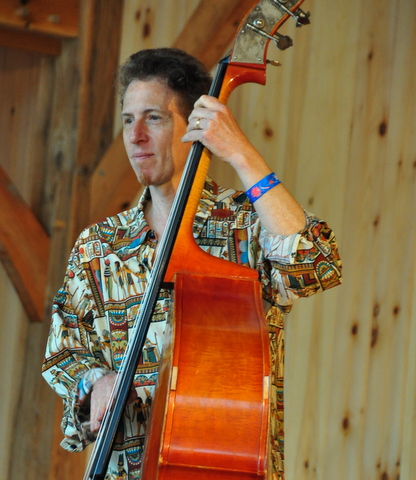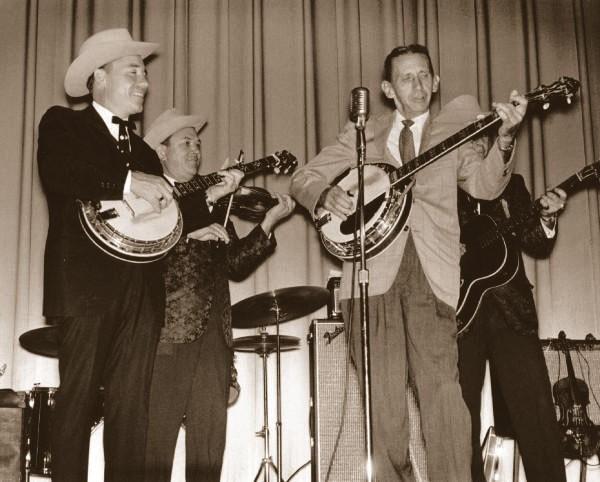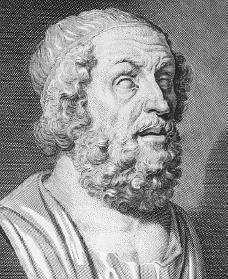Earl Scruggs:
An End And A Beginning
(Or, What Does a Banjo Player Have in Common with Homer and Sir Isaac Newton?)
By Ira GitlinIT DID MY heart good to see how widely and thoroughly the news media covered the recent death of Earl Scruggs. Newspapers from every corner of the nation noted his passing, as did television and radio. Even the English-language service of Al Jazeera, the Qatar-based Arabic news network, aired a short item.
For several days news outlets hummed with the details of Earl’s long career: his childhood in the little community of Flint Hill, North Carolina; his absent-minded discovery, at age ten, that he could pick the banjo with his thumb, index, and middle fingers, in what is referred to as “three-finger playing”; the sensation he created in 1945 when he first performed on the Grand Ole Opry with Bill Monroe and the Blue Grass Boys; his long partnership with Lester Flatt; the Earl Scruggs Revue; The Beverley Hillbillies and “Foggy Mountain Breakdown”; his unique role as the originator of one of the signature sounds of American music.
Flatt and Scruggs, ‘The Ballad of Jed Clampett’A CASUAL OBSERVER might have come away from all this with the impression that Earl created his style out of whole cloth, with nothing but his innate genius to guide him. In fact, three-finger banjo playing dates back to the time of the Civil War.
Nowadays, when people hear the term “minstrel show,” all it calls to mind is degrading stereotypes of Black Americans. But the minstrel show was so much more than that. It was the dominant form of popular entertainment in the second half of the 19th century. In an era before records, movies, and television, the minstrel show was like top-40 radio, first-run cinema, and prime-time TV all rolled into one. And the banjo—originally brought here by enslaved West Africans--was central to its mix of music, comedy, and drama.
The first minstrel banjoists used an African-derived technique that involved striking the strings with the back of a fingernail, which lives on in modern “clawhammer” (or “frailing”) playing. Then, around the 1860s, some banjo players began using their index and middle fingers to pick upwards, while the thumb picked downwards as it always had. A rising generation of virtuosos used this versatile “guitar style” for song accompaniments, transcriptions of classical pieces, ragtime, and marches. In the late 19th century the banjo was everywhere, just as the guitar would be in the 20th century.
By World War I the five-string banjo had all but disappeared from commercial popular music, but it was still being played in a wide variety of folk styles throughout the South. Three-finger banjo picking put down roots in the Carolina Piedmont region, where Earl was born in 1924.
A 1927 RECORDING by Charlie Parker and Mack Woolbright offers a glimpse of the state of the Carolina three-finger art around the time of Earl’s childhood. Between the verses of “The Man That Wrote ‘Home Sweet Home’ Never Was A Married Man,” Woolbright plays “Home Sweet Home” on his banjo. The similarities with and differences from Earl’s 1961 recording of “Home Sweet Home” are striking. Earl uses the same chord voicings as Woolbright, including the G7 chord that he remembered as “one of the most thrilling sounds I had ever heard.” But the earlier recording—quite fine in its own way—is stiffer and squarer than Earl’s syncopated, fluid version.
‘A glimpse of the state of the Carolina three-finger art around the time of Earl Scruggs’ childhood’: Parker and Woolbright, ‘The Man That Wrote Home Sweet Home Never Was a Married Man,’ 1927.
From 1961, Flatt and Scruggs’ version of ‘Home Sweet Home’Woolbright was one of the players, along with Smith Hammett, Rex Brooks, and Mack Crow, that Earl mentioned hearing in his earliest years. But a new, more dynamic three-finger style soon came along in the playing of DeWitt “Snuffy” Jenkins (1908-1990).
In February 1990, two months prior to his death in April of that year, Snuffy Jenkins fired up his banjo to join the Hired Hands on ‘Long Journey Home.’“THERE WAS OTHER fellas that played with three fingers before Snuffy, but he was the first one who ever put it together. It’s like seeing a river winding and you don’t know where it’s going and then finally you see it straightened out going into the ocean…. He had perfected, as far as I’m concerned, a three-finger roll,” said bluegrass banjo great Don Reno (interviewed by Tony Trischka in the 1980s).
Where Woolbright picked with bare fingers on a light, open-backed instrument, Snuffy used metal fingerpicks on a Gibson Mastertone banjo for a loud, bright tone that would become the bluegrass norm. His flowing “forward roll” (a repeating thumb-index-middle picking sequence) introduced an exciting element of syncopation. Just as important, Snuffy was widely heard on the radio in North Carolina, performing with J.E. Mainer, Byron Parker, and other hillbilly music stars. Earl, Don Reno, Ralph Stanley, and other young players in the 1930s and early ’40s were fascinated by the sound.
It’s difficult to form a picture of Snuffy’s playing in his prime. Early recordings of him are few and hard to find. Later recordings date from his middle age, when he was no longer a full-time musician, and from his final years, when old age had blunted his abilities. But by some accounts Snuffy’s circa-1940 playing rivaled what Earl would unleash upon the world a few years later.
‘By some accounts Snuffy’s circa-1940 playing rivaled what Earl would unleash upon the world a few years later.’: Earl Scruggs and Snuffy Jenkins in an undated photo from the 1960s.Indeed, our earliest recordings of Earl’s playing (live Grand Ole Opry air checks from March 1946, when he was 22 years old), while undeniably electrifying, are somewhat rough and simplistic. But Earl continued to grow, both technically and artistically. His last recording session with Bill Monroe, in October 1947, showcased the Earl we all recognize, and by the early 1950s, when banjo players around the country were emulating him, he had no equal. It may have been a quirk of fate that put Earl up on the Opry’s 50,000-watt pedestal, but fate chose the right man.
OBITUARIES HAVE COMPARED Earl’s influence to that of trumpeter Louis Armstrong, whose power and finesse stunned the jazz world in the 1920s, or of Andrés Segovia, the 20th-century performer, teacher, and composer who almost single-handedly restored the classical guitar to the prominence it had enjoyed a hundred years earlier. We could also liken him to pioneering electric guitarist Charlie Christian, who came out of nowhere in the late 1930s to attain national prominence with an innovative style that changed the way people viewed his instrument. I like to look beyond the world of music, though, for a couple of parallels that may illuminate Earl’s position in bluegrass and in the traditions out of which bluegrass grew.
Sir Isaac NewtonLET’S START WITH Isaac Newton. Building upon the work of earlier thinkers—the mathematics of Archimedes, the physics of Galileo, the astronomy of Johannes Kepler—Newton put physical science on a firm footing. His 1687 work Philosophiæ Naturalis Principia Mathematica (“Mathematical Principles Of Natural Philosophy”) defined essential concepts, articulated fundamental natural laws, and introduced a mathematical framework (calculus) that made detailed analysis possible.
All later advances in physics—electromagnetism, thermodynamics, even the weird realms of relativity and quantum theory—rest solidly on the foundation that Newton laid down. “If I have seen further,” Newton wrote modestly, “it is by standing on the shoulders of giants.” But today Newton himself is the giant on whose shoulders all physicists stand.
If you’re not a banjo player you may think it’s a little overblown to compare a country musician to this towering figure who changed the very terms in which we understand our world, but I think the comparison is an apt one. Both Newton and Earl took what came before them, added to it, and transformed it so thoroughly and compellingly that all who toiled in the same field after them would use their work as a paradigm.
HomerWE COULD ALSO look back nearly three millennia to Homer, the legendary Greek poet whose two epics, the Iliad and the Odyssey, stand at the very beginning of Western literature. We don’t really know anything about Homer the man—including whether a single poet named “Homer” actually composed those great works—but to the ancient Greeks, the Iliad and Odyssey represented everything that their culture valued, an inspired and inspiring summation of what it meant to be Greek. They admired Homer’s noble style, his narrative structures, his ability to comprehend all facets of human experience. Later authors produced sophisticated works beyond anything that Homer could have imagined, but they all agreed that he was the master of them all. The playwright Aeschylus said that his own work consisted of picking up “crumbs from the great banquet of Homer.”
The parallel, I trust, is obvious: Homer and Earl were both there at the beginning, they both cast a long shadow over everything that came after, and in the opinion of later generations, their work could not be improved upon.
But keep reading; it gets better.
If you read the Iliad or the Odyssey in high school, you probably noticed the many repeated phrases (like “rosy-fingered dawn”) that pepper the poems, repeated lines (“Then in answer to him spoke swift-footed Achilles”), or even entire repeated scenes. Scholars in the 1920s and ’30s demonstrated that these rhythmic, modular “formulas” had enabled Homer and his contemporaries to improvise their poems in real time without the use of writing, like present-day rappers. In other words, Homer was using licks, like the “tag lick” that banjo players use to adorn the end of a verse, or the “Cripple Creek” lick that we can use when we need to fill up one beat of a G chord—or, when you come down to it, like most of what makes up Scruggs-style playing. (Although I drew this analogy on my own when I was a college student, I later learned that it had already been suggested by banjo-playing folklorist Thomas Adler in the mid-1970s.)
Homer’s system of formulas was so complex and extensive, scholars argue, that it must have developed over many generations. As a young man Homer would have learned all the formulas that the tradition handed down to him—he might also have created some of his own—and the ways they could be combined to tell the traditional stories. In the hands of a beginner or an uninspired amateur, this process would produce serviceable but commonplace verse. A genius like Homer—or Earl—however, could use the same technique and vocabulary to create works of beauty, insight, and emotional power.
In the 1930s the American classicist Milman Parry tested this theory of “oral-formulaic composition” by traveling to the backwoods of Yugoslavia, where he found illiterate bards still improvising epic poems about the medieval battles between the Serbs and the Turks. Had he traveled instead to Flint Hill, would he have recognized the same process at work in the lively tunes that his compatriots were playing there? And would he have noticed that one shy boy played with a spark that set him apart from the rest?
IF EARL HAD come along just a little earlier, his artistry would now be no more than a legend, or a faded memory shared by an ever-dwindling number of elderly music–lovers. But, like Homer, he had the good fortune to come along at a unique moment in history, when a revolutionary communication technology made it possible to preserve and disseminate his performances. For Homer, that technology was writing, which was re-introduced to Greece around 800 BCE after centuries of illiteracy. For Earl, it was the phonograph and especially the radio that enabled the world to hear what three fingers could do on five strings. His music was both an end and a beginning—the culmination of the tradition he had inherited and the foundation of a new one.
©2012 Ira GitlinIra Gitlin is a musician and teacher in the Washington, DC, area. He has performed with Bill Harrell, the Johnson Mountain Boys, Laurie Lewis, and Peter Rowan. In 1992 he won the National Bluegrass Banjo Championship in Winfield, Kansas, and in 1993 he was a one-day winner on Jeopardy. For more information and to contact Ira, visit his website at www.iragitlin.com .
Founder/Publisher/Editor: David McGee
Contributing Editors: Billy Altman, Laura Fissinger, Christopher Hill, Derk Richardson
Logo Design: John Mendelsohn (www.johnmendelsohn.com)
Website Design: Kieran McGee (www.kieranmcgee.com)
Staff Photographers: Audrey Harrod (Louisville, KY; www.flickr.com/audreyharrod), Alicia Zappier (New York)
E-mail: thebluegrassspecial@gmail.com
Mailing Address: David McGee, 201 W. 85 St.—5B, New York, NY 10024






